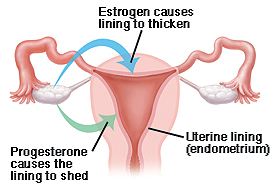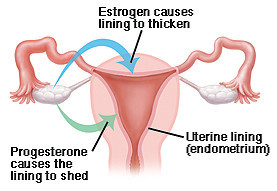Menstrual periods should occur every 21 to 35 day on a repetitive (i.e. predictable) cycle. A few days variance is common and is not cause for concern. Yet 8 to 10% of reproductive age women have very unpredictable menstrual cycles. This often reflects the inability to ovulate since the ovaries produce the hormones—estrogen and progesterone—that control the growth and sloughing of the inner uterine lining.
Ovulation during a normal menstrual cycle creates a mature follicle—which is a cystic (fluid-filled) structure. The size of a mature follicle that is ready to ovulate is about the size of a ping pong ball. It then opens and releases a pinhead-sized egg floating in fluid (ovulation video).
- During the first phase, the follicle produces estrogen that stimulates the growth of the inner uterine lining. The length of this phase may vary.
- The follicle will only produce progesterone for a fixed period of 14 days after ovulation, preparing the inner uterine lining for implantation of a fertilized egg. If pregnancy does not occur, then hormone production temporarily ceases and without stimulation the uterine lining sheds, resulting in a menstrual period.

Ovarian Dysfunction—AKA Polycystic Ovarian Syndrome (PCOS)
- The basic difference between polycystic and normal ovaries is that although the polycystic ovaries contain many small follicles with eggs in them, the follicles do not develop and mature properly, so there is no ovulation.
- Since women with polycystic ovaries do not ovulate regularly, they do not get regular menstrual periods. While they make abundant amounts of estrogen, they fail to make progesterone. As a result, the timing, duration, and heaviness of periods are unpredictable. Some women hemorrhage or become anemic from iron deficiency.
- Symptoms:
- There is a spectrum of ovarian dysfunction ranging from inconsistent ovulation to none at all. Consequently, bleeding patterns vary from modestly irregular menstrual cycles to sometimes a total lack of periods.
- Excess undesired facial and body hair, as well as acne, occur because the ovaries are making excess amounts of the male hormone testosterone.
- Blood tests measuring hormones are important to exclude other causes of ovarian dysfunction such as thyroid conditions or pre-diabetes.
- Many women with PCOS are overweight. Ironically, women with eating disorders like anorexia and bulimia or those participating in extreme exercise often have ovarian dysfunction.
Treatment
- If a woman suffering from PCOS is trying to get pregnant, then she would be prescribed “fertility drugs,” such as Clomid or medication called metformin to help her ovulate.
- There are treatment options available for women with PCOS who are not currently interested in pregnancy that can help them have regular menstrual cycles with lighter and shorter flow. Birth control pills accomplish this very well. They also reduce the testosterone production and consequently reduce undesired hair growth and acne. Alternatives are cyclic progesterone medication or use of the Mirena IUD.
It is very common to experience transient menstrual irregularities during adolescence and also as you approach menopause. As long as menstrual bleeding is not disruptive to activities of daily living, too heavy, or too prolonged, then this can be simply observed. Otherwise, it’s best to seek care to normalize bleeding patterns and avoid consequences of anemia.
Wishing you good health,
Scott Kramer MD, FACOG











Speak Your Mind